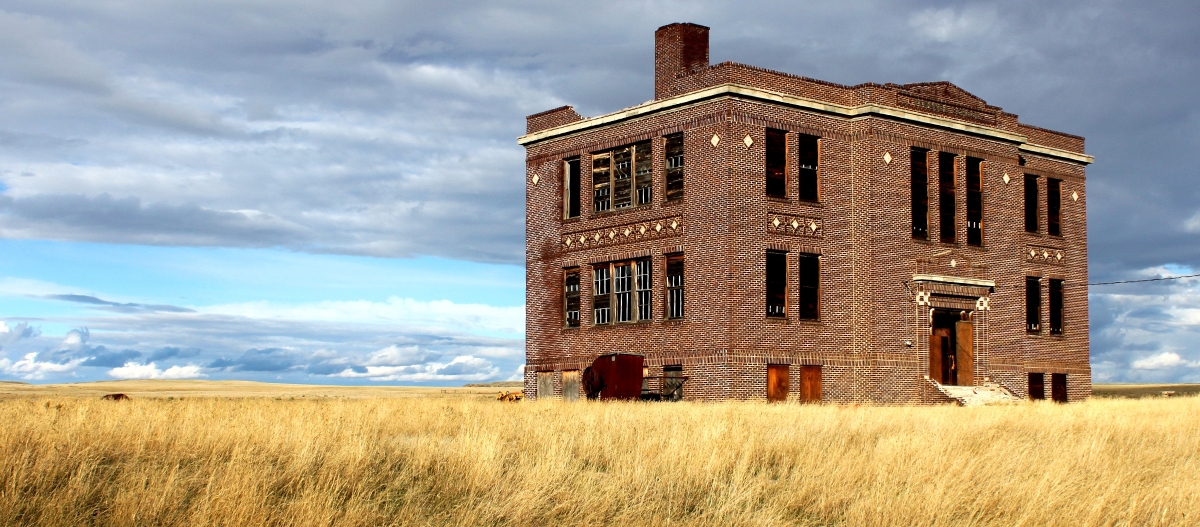By SUZANNE WARING
Throughout the country, urban sprawl gobbles up smaller communities. Highways are jammed with cars. Construction of new highway lanes to ease traffic congestion adds to confusion. Housing developments devour farm land.
Even in Montana, most of the population live in larger towns and usually shop, work, and have fun by staying within those towns.
For that reason, the countryside along Highway 12 between Roundup and Forsyth should not be dismissed, or, for that matter, avoided. The rolling hills and broad sky provide an opportunity for travelers to settle into open spaces and learn the history of the area.
With meeting fewer than a half-dozen cars for the hundred miles between the two rural towns, a dichotomy to our daily stressful lives becomes obvious.
Along the way, a lone building emerges on the horizon and stands as a stark contrast against the prairie. It offers an enigma for the traveler to contemplate. A sign states that this is Vananda, but where is the town?
Spur of the Moment
Vananda was created when the Chicago, Milwaukee, St. Paul and Pacific Railroad—called the Milwaukee by Montanans—built a spur through the area in 1907-1908 on its way to the Musselshell valleys. Needing a water stop for the steam locomotives, the railroad built a depot and a reservoir south of what would become the town.
Railroad employees took up residence around the depot, and because of the convenience of the railroad stop, others came to homestead in the surrounding area.
The influx of people started around 1908, and by 1915 approximately 200 people lived in the town, which had a bank, hotel, restaurant, lumberyard, grain elevator, mercantile, two churches, a post office, and, for a short time, a weekly newspaper.
A small clapboard school was built and also used for community activities, such as dances. Until 1917, unusually high rainfall and good wheat prices brought a living wage and hope for the future to the farmers, but the following years of drought, especially in the 1920s, forced farming families to move away, and the businesses in town started into slow decline.
Grazing of sheep and cattle had occurred before the homestead era, and the area reverted to that industry, which called for fewer people.
Steam to Diesel
Another reason for the decline of the town occurred when diesel locomotives replaced steam locomotives, eliminating the need for water stops. The railroad moved their employees elsewhere. Even the railroad spur itself was abandoned in 1980.
The school building that we continue to see today was built in 1920 and replaced the clapboard school. A two-story brick building with a partial daylight basement was something to be revered.
The decorative brickwork catches the observer’s eye because of the contrast to the plain terrain. The windows are either boarded up or broken out, but the exterior brickwork is in amazingly good condition.
Cal McConnell’s mother went at least to the first grade at the Vananda School. She lived with her aunt and uncle, who was the depot agent.
“By the time the school building was finished, the population had started to decline. An elaborate coal/wood heating system that also burned the sewage had been installed in the school. It was forward thinking for the time, but not all of the rooms were needed any longer, so they didn’t use the heating system, but instead put in coal-burning stoves in each of the rooms that were used,” said McConnell, who lives in Forsyth.
All but Disappeared
It is unknown the last time the building was used as a school. After that, people did go there to vote. The building has not been used since the mid 1950s and hasn’t been kept in good condition as a community center—most likely because there weren’t enough people in the area to maintain or use it.
By the 1980s only one house remained in what was the town proper but was only occasionally occupied. Vananda had all but disappeared.
Travelers must stop to take in how the dirt and native grass reclaimed what was here once. Only the sturdy shell of the brick school building remains of what was a thriving little community a hundred years ago.
Possibly travelers will feel a certain loneliness in the school yard where the sweeping wind now replaces student voices and laughter. But even with that reflection possibly something else emerges. Vananda welcomes travelers with the only amenity it has to offer. While there, they will feel the freedom of the open spaces that are becoming a premium. Even for the short amount of time travelers visit the townsite and school yard, they will find a certain relief from the strife of urban life and may revel in it. — MSN









